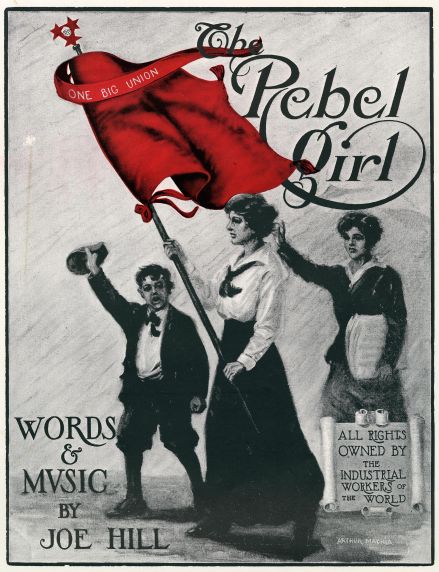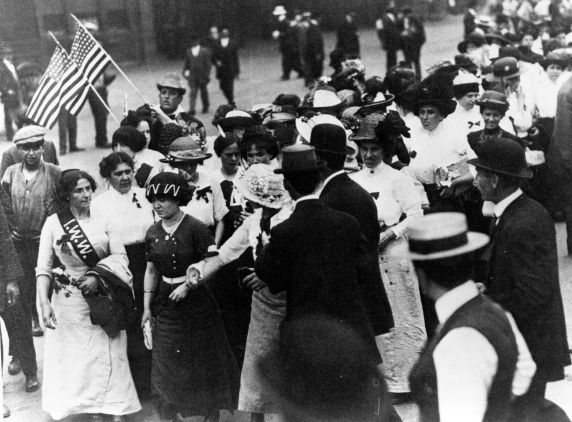The Women of the Industrial Workers of the World (I.W.W.)
The Industrial Workers of the World (I.W.W.) was one of the first industrial unions to adopt the concept of gender equality and extend its membership to women. From its very inception, as organizers, agitators, advocates, and active members, women played an important part in the union’s development.
The I.W.W. was formed in 1905 after William Haywood called for a meetings of anarchists, syndicalists, and trade unionists to come together in Chicago. The goal was to form “One Big Union”—to create a system of industrial unionism that organized workers across industry instead of craft or trade. The class-conscious perspective of the union was appealing to many activists, and in turn twelve of the founding members of the union were women, among them pioneers such as Mother Jones and Lucy Parsons.
The women of the I.W.W. quickly became mainstays in the public eye, partially due to the unconventional nature of their organizing activities, but mostly because of their skills in getting the message across. Lucy Parsons, Elizabeth Gurley Flynn, and Matilda (Rabinowitz) Robbins were powerful orators and motivated countless supporters to join in the union’s cause. Inspired by Gurley Flynn, I.W.W. troubadour Joe Hill famously wrote The Rebel Girl, a song still widely sung, that came to personify the role of the woman in the union as fearless, kind, and devoted to the cause of the working class. While the Rebel Girl may have been written about Flynn, the sentiment carried across into the union’s worldview.  The I.W.W. viewed women as activists and equal partners, rather than simply auxiliary support. Women were active in the union in all corners of the world, but had the greatest influence in the eastern region of the United States. As opposed to the western states, where workers tended to be more migratory in nature, the eastern region was filled with factories where women toiled in garment work, textiles, and tobacco manufacturing. The rank and file women in these factories played important roles in the struggle for better working conditions and wages. In particular, they proved themselves essential during the Lawrence Textile Strike of 1912 and the Paterson Silk Strike of 1913, putting themselves at the front lines of the struggle, which resulted in numerous injuries and arrests.
The I.W.W. viewed women as activists and equal partners, rather than simply auxiliary support. Women were active in the union in all corners of the world, but had the greatest influence in the eastern region of the United States. As opposed to the western states, where workers tended to be more migratory in nature, the eastern region was filled with factories where women toiled in garment work, textiles, and tobacco manufacturing. The rank and file women in these factories played important roles in the struggle for better working conditions and wages. In particular, they proved themselves essential during the Lawrence Textile Strike of 1912 and the Paterson Silk Strike of 1913, putting themselves at the front lines of the struggle, which resulted in numerous injuries and arrests.
Elizabeth Gurley Flynn famously dismissed criticism regarding the women’s participation strikes: "The IWW has been accused of pushing women to the front. This is not true. Rather, the women have not been kept in back, and so they have naturally moved to the front." In the strikes and in the overall struggle for better social and working conditions for the working class, the women of the I.W.W. were more than inspiration to workers or talking points for the papers--they were early pioneers in the movement for equality between the sexes and the inclusion of women in organized labor.
When researching the role of the women in the I.W.W., there is no better place to start than the Industrial Workers of the World Records, a resource that documents the hardships that the working class had to overcome, through correspondence, trial records, meeting minutes and union proceedings, and pamphlets. The Elizabeth Gurley Flynn Papers is a small collection with a large impact in understanding the personal, later life of the I.W.W.’s most famous female member. It consists primarily of family correspondence written while Flynn was in prison and while traveling in the Soviet Union, Eastern Europe, and the western United States in the 1960s, and contains political commentary as well as her impressions of prison life and her travels. For a broader view of her life experiences, we suggest listening to an oral history interview with Elizabeth Gurley Flynn. Recorded in 1962, it is a frank conversation with Flynn in which she discusses her upbringing and entry into the political scene as the “girl orator,” her organizing efforts and labor defense work on behalf of the Industrial Workers of the World (I.W.W.), and the evolution of her political beliefs. Of particular interest is a description of her arrest under the Smith Act and her years spent in prison at the Women’s Reformatory in Alderson, West Virginia.
The poet, feminist, and activist Matilda (Rabinowitz) Robbins was an early organizer and a lifelong advocate and writer for the One Big Union. She first became involved with the I.W.W. during the Lawrence Strike as a volunteer, and later proved her mettle during the Little Falls Textile Strike where she became the central strike organizer after the other organizers were jailed. For 14 weeks she ran the strike office, organized the daily picket lines and strike kitchen, arranged for legal aid for the jailed workers, and recruited support, with the help of fellow I.W.W. member Helen Schloss. For three years following she traveled the country, organizing textile workers in the East and autoworkers in Detroit, where she was jailed for her activities. The Matilda Robbins Papers, contain personal writings, photographs, and clippings and are a tremendous resource toward understanding the philosophies of an early women’s rights activist.
The papers of the labor journalist and activist Mary Heaton Vorse will also prove insightful for the student of the I.W.W. Though not a Wobbly herself, Vorse intersected with the I.W.W. throughout her career. Her papers include writings on: the I.W.W.; the textile strikes of Lawrence, MA and Henderson, NC; the Sacco-Vanzetti case; the Palmer Raids and criminal syndicalism cases (1921-23); as well as correspondence with Elizabeth Gurley Flynn.
The papers of the husband and wife team of Charles and Jennie Velsek offer information on the pair’s labor organizing activities. Charles served as secretary of IWW Agricultural Workers Industrial Union (AWIU) Local 110, and for a brief period, as chairman of the IWW General Executive Board. Jennie was an active figure in the labor movement, and participated in many I.W.W. strikes.
William Haywood’s personal secretary, Elizabeth Serviss Fox formed unique relationships with the leadership of the union. In the guise of three handwritten letters from Haywood, Serviss Fox’s papers offer a uniquely personal view into the events that surrounded Haywood’s legal appeal process and his eventual flight to Russia.
Finally, for photographs, graphic materials, and images of artifacts, please look through our Women of the I.W.W. Image Gallery. Within it one will find images of I.W.W. members such as Elizabeth Gurley Flynn, Matilda Robbins, Mother Jones, the Australian activist Violet Wilkins, Minnie Wyman, Elizabeth Serviss Fox, Helen Keller, and unknown rank and file women participating in strikes, recreational, and organizing activities. Of particular note are digital images of a hand beaded pennant and purse, made by an I.W.W member while in prison, as well as an inscribed club made from a loom and used during the Lawrence Textile Strike.
- eclemens's blog
- Login to post comments
- Printer-friendly version


 Reddit
Reddit Facebook
Facebook LinkedIn
LinkedIn